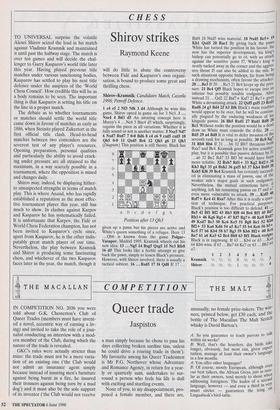CHESS
Shirov strikes
Raymond Keene
TO UNIVERSAL surprise the volatile Alexei Shirov seized the lead in his match against Vladimir Kramnik and maintained it until past the halfway stage. The match is over ten games and will decide the chal- lenger to Garry ICasparov's world title later this year. Having played previous title matches under various sanctioning bodies, Kasparov has settled to play his next title defence under the auspices of the 'World Chess Council'. How credible this will be as a body remains to be seen. The important thing is that Kasparov is setting his title on the line in a proper match.
The debate as to whether tournaments or matches should settle the world title came down in favour of matches as early as 1886, when Steinitz played Zukertort in the first official title clash. Head-to-head matches between two contenders are the severest test of any player's resources. Opening preparation, personal qualities and particularly the ability to avoid crack- ing under pressure are all strained to the maximum, in a way scarcely possible in a tournament, where the opposition is mixed and changes daily.
Shirov may, indeed, be displaying hither- to unsuspected strengths in terms of match play. This is where Anand, who has rapidly established a reputation as the most effec- tive tournament player this year, still has much to show. In clashes against ICarpov and Kasparov he has systematically failed. It is unfortunate that Karpov, the Fide or World Chess Federation champion, has not been invited to ICasparov's cycle since, apart from Kasparov, he is the other indis- putably great match player of our time. Nevertheless, the play between Kramnik and Shirov is producing some fascinating chess, and whichever of the two Kasparov faces later in the year, the match, though it will do little to abate the controversy between Fide and Kasparov's own organi- sation, is bound to produce some great and thrilling chess.
Shirov—Kramnik: Candidates Match, Cazorla 1998; Petroff Defence.
1 e4 e5 2 N13 Nf6 3 d4 Although he wins this game, Shirov opted in game six for 3 Nc3. 3 ... Nxe4 4 Bd3 d5 An amazing concept here is Murey's 4 ...Nc6 5 Bxe4 d5 which, surprisingly, regains the piece in all variations. Whether it is fully sound or not is another matter. 5 Nxe5 Nd7 6 Nxd7 Bxd7 7 0-0 Bd6 8 c4 c6 9 cxd5 cxd5 10 Qh5 0-0 11 Qxd5 Bc6 12 Qh5 g6 13 Qh3 (Diagram) This position is still theory. Black has given up a pawn but his pieces are active and White's queen something of a refugee. Here 13 Qb6 is known from the game Pulgar- Yusupov, Madrid 1995. Kramnik wheels out his new idea. 13 ... Ng5 14 Bxg5 Qxg5 15 Nc3 Rfe8 16 d5 This looks like a feeble attempt to give back the pawn, simply to lessen Black's pressure. However, with Shirov involved, there is usually a tactical subtext. 16 ...Bxd5 17 f4 Qd8 If 17 ...
Bxf4 18 Nxd5 wins material. 18 Nxd5 1k5+ 19 Kht Qxd5 20 Rae! By giving back the pawn White has turned the position in his favour. He now has the superior development, his king s bishop can potentially go to c4, with an attack against the sensitive point 17, White's king IS neatly tucked away in the corner and the aggres- sive thrust f5 can also be added to the mix. In such situations opposite bishops, far from being a drawing mechanism, often favour the attacker. 20 ...Be3 If 20 ...Re3 21 Bc4 keeps up the pres- sure. 21 Bc4 Qf5 Black hopes to escape into an inferior but possibly tenable endgame. After instead 21 ... Qd2 22 Bxf7+ Kxf7 23 Rc7+ gives White a devastating attack. 22 Qxf5 gxf5 23 Red/ RadS 24 g3 Bd4 25 b3 Bf6 Black's main troubles would appear to be over, but he will be contin'1. ally plagued by the enduring weakness of kr„s kingside pawns. 26 Bb5 Rxdl 27 Rxdl Rd8 2' Rd Without rooks the position would be a dead draw so White must concede the d-file. 28 ••• Rd5 29 a4 Bd8 It is vital to defer invasion of the seventh rank for as long as possible. 30 Rc8
31 RbS Bb6 If 31 ...b6 32 Rb7 threatens both Rxa7 and Bc4. Kramnik goes for active counter
play, but it is possible that passive defence by 31 ...a6 32 Be2 Rd7 33 Bf3 b6 would have been more reliable. 32 Rxb7 Rdl+ 33 Kg2 Rd2+ 34 ICh3 Bgl 35 g4 Bxh2 36 gxf5 h5 37 Kh4 13xf4 38 lixb5 Kf6 39 Bc4 Kramnik has certainly succeed- ed in eliminating a mass of pawns, one of tfte weaker side's major goals in such endgarne Nevertheless, the mutual extinctions have, anything, left his remaining pawns on 17 and a? even more vulnerable to attack. 39 ...Kx15 4° Barr+ Ke4 41 Rxa7 After this it is really a ques- tion of technique. For practical purposes, Black's position is too difficult to defend. 41 • •. Be5 42 Bff R12 43 Bh3 RfS 44 Be6 R11 45 Rd/ Rh1+ 46 Kg6 Rgl + 47 Kf7 Rg7+ 48 Ke8 BA! 49 Kxd7 Bc3 50 Kc6 Ke5 51 Bg8 Bel 52 Kb" Bf2+ 53 Ka6 Kd6 54 a5 Kc7 55 b4 Kc6 56 b5+ Kc5 57 b6 Kb4 58 b7 Bg3 59 Kb6 Bf2+ 60 Ke6 Ba7 61 a6 Ka5 62 Bc4 Bb8 63 Bfl Black resi05 Black is in zugzwang. If 63 ...Kb4 or 63 ..-Ka4 64 Kb6 wins, if 63 ... Ba7 64 Kc7 or 63 ...Bh2°4 a7.
1 2 3 4 5 6 7
Kramnik
1/2 1/2
1/2 0 1/2 1/2 1/2
3
Shirov
1/2 1/2 1/2
1
1/2 1/2 1/2 4


























































 Previous page
Previous page